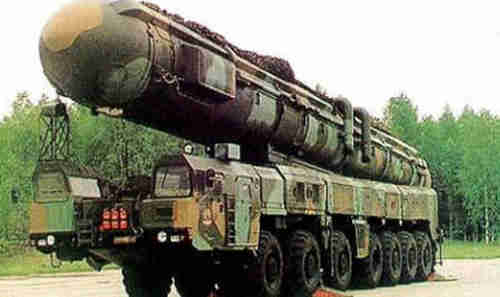This morning’s key headlines from GenerationalDynamics.com
- China close to deploying very long range DF-41 missile
- China-US differences sharpen over South China Sea
China close to deploying very long range DF-41 missile

Mobile DF-41 missile
China is in the final phase of testing the world’s longest range missile, the DF-41, with an operational range of 14,500 km. It can travel over the Pacific Ocean and strike any city in the western US, or travel over the North Pole and strike any city in the eastern US, in each case within about half an hour.
It is believed that each DF-41 is capable of carrying ten independently targetable nuclear weapons. A typical Chinese Second Artillery Corps (SAC) might have 12 missile launchers capable of launching two DF-41s each, so a single SAC has the capability to target the United States with 120-240 nuclear warheads.”
The DF-41 is expected to be deployed by the end of this year.
I’m always somewhat bemused when people make comments that the greatest existential threat to the United States is the so-called Islamic State (IS or ISIS or ISIL or Daesh), or even Iran. Either of those threats is minuscule compared to the threat from China.
For years, I’ve been writing about one Chinese missile system after another, specifically designed to strike American aircraft carriers or American cities. China has the manufacturing capacity to produce hundreds of these missiles, and clearly is preparing for war and planning to use them. Compared to China, ISIS really is junior varsity. South China Morning Post and Express (London) and China Topix
China-US differences sharpen over South China Sea
A meeting between president Barack Obama and China’s president Xi Jinping at the Nuclear Security Summit in Washington on Thursday is being called “constructive,” and it was constructive, if by “constructive” you mean that it provided a forum for sharp disagreements bordering on military threats.
On Wednesday, prior to the meeting, a Dept. of Defense spokesman announced that the US would not recognize an “air defense identification zone” (ADIZ) in the South China Sea, in case China decided to impose one.
The spokesman said that the US expects a ruling from an international court within the next few weeks on a case brought by the Philippines against China over its claims to the entire South China Sea. The fear is that China would react angrily to an adverse ruling and try to impose an ADIZ in the South China Sea, just as it did in the East China Sea near Japan in 2013. The US refused to recognize that ADIZ either.
If an ADIZ in the South China Sea were recognized, then any foreign aircraft would have to ask permission from China to fly through it. US officials have repeatedly said that the US military would fly, sail and operate wherever international law allows.
Xi responded by warning the US that China would not accept violations of its sovereignty in the name of freedom of navigation. Xi is quoted as saying, “The hope is that all parties will correctly view and handle the South China Sea and adopt an objective and impartial attitude… particularly countries outside this region.”
Some $5 trillion in trade passes through the South China Sea on ships each year, including $1.2 trillion of US trade.
China had pledged never to militarize the South China Sea, but has reneged on that promise, suggesting that nothing that China says is to be believed. China has built several artificial islands in the South China Sea and converted them into military bases with military aircraft and advanced radar, the military force that would be used to try to enforce an ADIZ. Reuters and The Hill and South China Morning Post
KEYS: Generational Dynamics, China, DF-41 Missile, South China Sea, Japan, East China Sea, Air Defense Identification Zone, ADIZ, Xi Jinping
Permanent web link to this article
Receive daily World View columns by e-mail

COMMENTS
Please let us know if you're having issues with commenting.